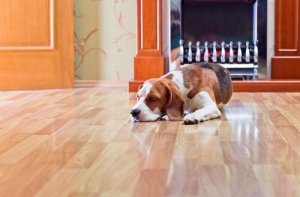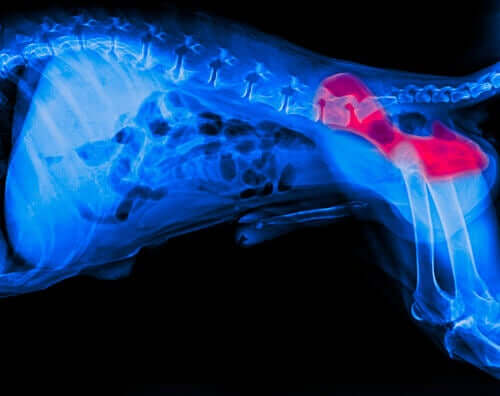The Dangers of Laminate Floors for Dogs


Written and verified by biochemistry Luz Eduviges Thomas-Romero
There are many reasons why homeowners prefer laminate floors to other more traditional options. If you have children or pets, then this probably sounds like the most cost-effective and easy-to-maintain choice. However, it’s also important to be aware of the dangers that laminate floors for dogs. After all, they’re the ones that will spend most of their lives at home and in direct contact with your flooring.
A lack of grip: One of the dangers of laminate floors for dogs
Laminate floors have a finish that’s especially glossy and slippery. This surface is especially difficult for dogs to grip with their paws, causing them to slip and slide. As a result, dogs may experience bumps, sprains, strains, and even fractures. When dogs run on laminate floors and try to change direction, it’s quite common for them to suffer damage to their backs.
In this sense, this type of flooring is especially harmful to older dogs. For senior dogs, walking on laminate or wooden floors can be particularly difficult. They become startled when they slide out of control and this can cause them to feel extremely anxious. After an injury, they may become very reluctant to cross a slippery floor, which then limits their movement around the house.
The increased risk of hip dysplasia
As we mentioned above, dogs often experience back injuries after slipping on laminate floors. This kind of injury always requires treatment and special therapy in order to heal.

The dog breeds that are most prone to suffering hip dysplasia are German Shepherds. Walking on slippery floors can increase this risk and make their condition worse.
If you live in a home with laminate floors, then you need to make sure to cut your dog’s nails regularly. What’s more, avoid moisture on the floors and on your dog’s paws. Place non-slip rugs around the floor, especially in problem areas.
Exposure to volatile organic compounds
Volatile organic compounds (VOC) are gases that are released as materials age and degrade over time. There are hundreds of VOCs, which include compounds consisting of formaldehyde. The majority are common components in vinyl, adhesives, and varnishes.
Such compounds are often common in a variety of common household elements. These include paint, cleaning products, and floor coverings. Yes… carpets, woods, and laminate flooring can all be harmful to your health and that of your pets.
Laminate floors look like hardwood. However, they actually consist of several layers of material, including wood fibers and a photographic image of wood. The adhesives and resins used in laminate floors often contain formaldehyde.
Exposure to formaldehyde can cause allergic reactions like asthma, headaches, upper respiratory problems, rashes, and even cancer.

Are there less dangerous alternatives to laminate floors?
At this point, you’re probably wondering if there are options that are safer for your furry friend. Fortunately, the answer is yes. There are many flooring options that aren’t toxic. The best options are real hardwood, polished concrete, and tile. Also, you can look for specific certified brands of carpet, natural linoleum, and engineered wood.
Other non-toxic alternatives for people and animals with allergies include bamboo, cork, and recycled glass. In order to minimize VOCs found in adhesives, choose products that have a low VOC content or that are water-based.
Also, be aware that vinyl and synthetic carpets have a high VOC content. In their place, you can opt for natural fibers like wool, sisal, and cotton.
What about other types of flooring?
Possible health problems exist that can also appear as a result of other flooring materials. Vinyl floors often contain phthalates – or phthalates esters. This is a family of chemical compounds often found in plasticizers. Their main function is making rigid polymers more flexible.
Phthalates can act as endocrine disruptors and alter thyroid hormone levels. They can also cause obesity and a resistance to insulin.
There are many reasons why homeowners prefer laminate floors to other more traditional options. If you have children or pets, then this probably sounds like the most cost-effective and easy-to-maintain choice. However, it’s also important to be aware of the dangers that laminate floors for dogs. After all, they’re the ones that will spend most of their lives at home and in direct contact with your flooring.
A lack of grip: One of the dangers of laminate floors for dogs
Laminate floors have a finish that’s especially glossy and slippery. This surface is especially difficult for dogs to grip with their paws, causing them to slip and slide. As a result, dogs may experience bumps, sprains, strains, and even fractures. When dogs run on laminate floors and try to change direction, it’s quite common for them to suffer damage to their backs.
In this sense, this type of flooring is especially harmful to older dogs. For senior dogs, walking on laminate or wooden floors can be particularly difficult. They become startled when they slide out of control and this can cause them to feel extremely anxious. After an injury, they may become very reluctant to cross a slippery floor, which then limits their movement around the house.
The increased risk of hip dysplasia
As we mentioned above, dogs often experience back injuries after slipping on laminate floors. This kind of injury always requires treatment and special therapy in order to heal.

The dog breeds that are most prone to suffering hip dysplasia are German Shepherds. Walking on slippery floors can increase this risk and make their condition worse.
If you live in a home with laminate floors, then you need to make sure to cut your dog’s nails regularly. What’s more, avoid moisture on the floors and on your dog’s paws. Place non-slip rugs around the floor, especially in problem areas.
Exposure to volatile organic compounds
Volatile organic compounds (VOC) are gases that are released as materials age and degrade over time. There are hundreds of VOCs, which include compounds consisting of formaldehyde. The majority are common components in vinyl, adhesives, and varnishes.
Such compounds are often common in a variety of common household elements. These include paint, cleaning products, and floor coverings. Yes… carpets, woods, and laminate flooring can all be harmful to your health and that of your pets.
Laminate floors look like hardwood. However, they actually consist of several layers of material, including wood fibers and a photographic image of wood. The adhesives and resins used in laminate floors often contain formaldehyde.
Exposure to formaldehyde can cause allergic reactions like asthma, headaches, upper respiratory problems, rashes, and even cancer.

Are there less dangerous alternatives to laminate floors?
At this point, you’re probably wondering if there are options that are safer for your furry friend. Fortunately, the answer is yes. There are many flooring options that aren’t toxic. The best options are real hardwood, polished concrete, and tile. Also, you can look for specific certified brands of carpet, natural linoleum, and engineered wood.
Other non-toxic alternatives for people and animals with allergies include bamboo, cork, and recycled glass. In order to minimize VOCs found in adhesives, choose products that have a low VOC content or that are water-based.
Also, be aware that vinyl and synthetic carpets have a high VOC content. In their place, you can opt for natural fibers like wool, sisal, and cotton.
What about other types of flooring?
Possible health problems exist that can also appear as a result of other flooring materials. Vinyl floors often contain phthalates – or phthalates esters. This is a family of chemical compounds often found in plasticizers. Their main function is making rigid polymers more flexible.
Phthalates can act as endocrine disruptors and alter thyroid hormone levels. They can also cause obesity and a resistance to insulin.
All cited sources were thoroughly reviewed by our team to ensure their quality, reliability, currency, and validity. The bibliography of this article was considered reliable and of academic or scientific accuracy.
- Coon, R. A., Jones, R. A., Jenkins Jr, L. J., & Siegel, J. (1970). Animal inhalation studies on ammonia, ethylene glycol, formaldehyde, dimethylamine, and ethanol. Toxicology and applied pharmacology, 16(3), 646-655.
- Montes, P. B., Soberanis, B. L., Fernández, G. O., & Moreno, F. V. (2001). Ftalatos y efectos en la salud. Revista internacional de contaminación ambiental, 17(4), 205-215.
This text is provided for informational purposes only and does not replace consultation with a professional. If in doubt, consult your specialist.








